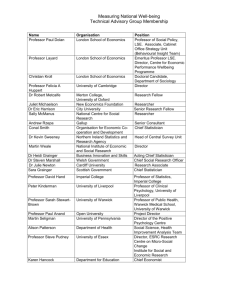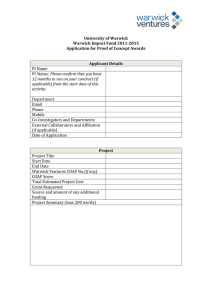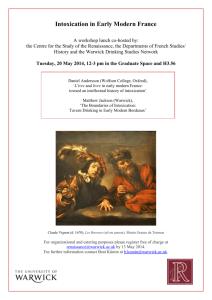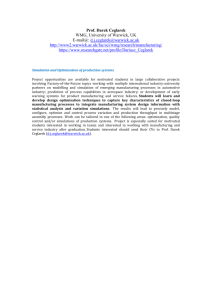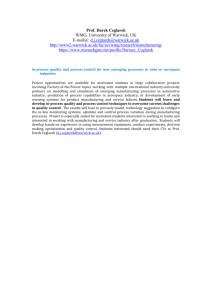Bulletin WARWICK ECoNomICS Spring 2013
advertisement
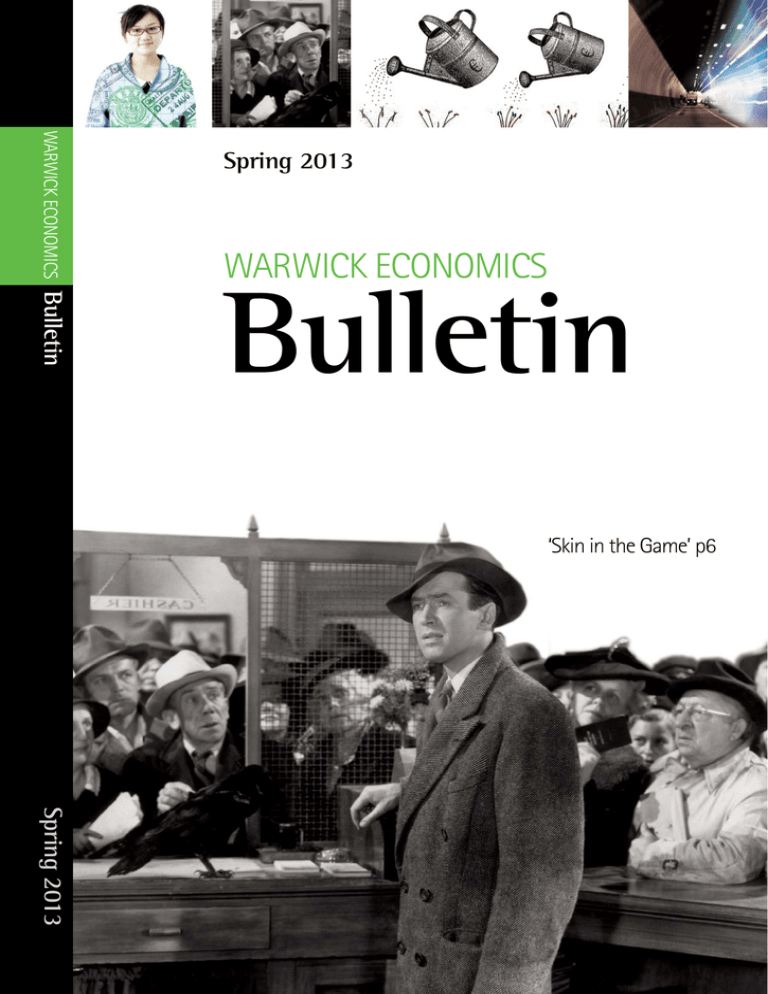
WARWICK ECoNomICS Spring 2013 WARWICK ECoNomICS Bulletin Bulletin ‘Skin in the Game’ p6 Spring 2013 Spring 2013 Warwick Economics Bulletin Workers Without Borders 3 ‘Skin in the Game’ 6 Do EU transfers spur growth? 8 New analysis examines the clash between the economic and political views of immigration Sharun Mukand, Sanjay Jain and Sumon Majumdar New insights from Depression-era banking regulations offer lessons for averting the next financial crisis Kris James Mitchener and Gary Richardson Changes are needed to make EU funds better levers for economic progress, new research shows Sascha O Becker, Peter H Egger and Maximilian von Ehrlich The Tunnel Effect The Final Word Abhinay Muthoo 10 The Bulletin is a publication of the University of Warwick Department of Economics and the Warwick Economics Research Institute. The institute was begun in 2007. It promotes quality research and enhanced public understanding of economic issues. It advocates the funding and organisation of research projects that have the potential to offer new insights into difficult economic issues and to lead to better-informed public policies. It supports scholarly activities such as conferences and research networks that extend beyond the routine scholarly life of the University of Warwick Department of Economics. Head of University of Warwick Department of Economics Director of the Warwick Economics Research Institute Abhinay Muthoo a.muthoo@warwick.ac.uk The Bulletin’s editor Karen Brandon k.brandon@warwick.ac.uk The Bulletin’s editorial consultant Romesh Vaitilingam romesh@vaitilingam.com Warwick Economics Research Institute Department of Economics University of Warwick Coventry CV4 7AL United Kingdom The Bulletin is freely available in electronic format from www.warwick.ac.uk/ go/eri/bulletin/ It is not copyrighted and may be reproduced freely with appropriate attribution of source. Please provide us with a copy of any material that you reproduce. The Bulletin Published 2013 Printed by Warwick Print Designed by DesignRaphael Ltd Workers Without Borders The Bulletin – Spring 2013 New analysis examines the clash between the economic and political views of immigration By Sharun Mukand I mmigration is one of the most polarizing issues in public policy. From an economics perspective, immigration arguably holds the most potential for development and poverty reduction. From a political perspective, immigration is one of the least viable policy options. The subject warrants more examination, particularly in light of current demographic trends that are affecting developing and developed countries. Recent work with Sanjay Jain and Sumon Majumdar explores the immigration controversy in detail and examines the cultural and political underpinnings of the debate. The potential gains from the globalisation of labour have the potential to dwarf those from foreign aid or even the liberalisation of trade and capital flows across borders. For example, a decision by developed countries to liberalise immigration restrictions by a mere 3 per cent could result in an estimated output gain of more than $150 billion. Yet, while many policymakers encourage greater mobility of goods, services and capital, the use of immigration as a development tool is rarely considered a palatable policy option. It is worth thinking about the issue in a historical light. More than three decades ago, economist John Kenneth Galbraith observed that migration has been the “oldest action against poverty” for most of human history. To put the immigration issue in its historical perspective, consider the rich-poor wage gaps for unskilled workers that drove the great 19th century migrations. During this period, wages in the United States were between two and four times higher than in European countries such as Ireland, Norway and Sweden. By contrast, by the start of the 21st century, wages in the developed world were six to nine times higher than in the developing world. From the perspective of developing countries, such wage gaps are likely to be the key drivers of future global migration patterns. At the same time, developed countries are facing a historically unprecedented demographic challenge. The increase in people’s life expectancy has been coupled with a decline in fertility, making sustaining pension and social security systems even more difficult. Consider the United States as an example. It enjoys a relatively high fertility rate among developed countries, and it has roughly five working-age individuals to support each senior citisen today. But this number is expected to drop by half by 2030. The situation is even more worrying in much of Europe, where the available working population to support every person of retirement age is already much smaller. All signs point to a looming demographic crisis that will only increase the strain on fiscal resources still further. In these circumstances, it is difficult to see how Migration has been the ”oldest action against poverty” for most of human history. The Authors Sharun Mukand is a professor in the Department of Economics at the University of Warwick and a research theme leader at its Centre for Competitive Advantage in the Global Economy (CAGE). Sanjay Jain is a lecturer in development economics at the University of Cambridge. Sumon Majumdar is an associate professor of economics at Queens University. 3 4 Warwick Economics Research Institute Workers Without Borders continued the developed world’s social security systems can remain solvent in the longer term. Something will have to give, leading to either a drastic curtailment of benefits or a far-reaching, gamechanging solution. One such solution could be to increase the influx of working-age migrants from developing to developed countries. Our world is increasingly integrated at numerous informational, technological and cultural levels. Globalisation of trade in goods and capital will eventually reach its limits. As a result, we believe that the issues raised by international labour mobility deserve exploration. The potentially huge economic gains from greater international labour mobility generally are ignored or little discussed. The reason is politics. Lowering the barriers to international migration inevitably results in ‘winners and losers,’ and these distributional effects feed into the political arena and often spark a political and social backlash. The biggest winner from expanded migration is usually the migrant worker, who pockets a large proportion of the resulting economic gains. However, the reason this becomes politically toxic is that the gains usually come at the expense of an existing worker in the destination country. The distributional effects of migration often depend on whether the worker is skilled or unskilled. For instance, a greater number of young, low-skilled migrants from Eastern Europe is likely to reduce the wages that native UK workers would be able to earn working in coffee shops. Low-skilled worker migration is likely to hurt those at the lower end of the economic spectrum. But at the same time, such migration usually benefits owners of capital and increases the benefits to consumers of goods that rely on less-skilled labour. As a result, policies that encourage the migration of low-skilled workers are likely to meet with political resistance, if not outright hostility, from many workers in the destination country. Compounding these effects is the perception that migrants typically are a drain on public finances by taking out more from the welfare system than they contribute through taxation. These fears have been exacerbated since the onset of the economic crisis in Europe and the United States, and such fears have helped to harden antiimmigration attitudes. However, the distributional impact should not be exaggerated. And such an impact is not unique to international labour mobility; the globalisation of trade in goods and in capital flows also gives rise to distributional effects. If attitudes in developed countries are far more hostile to the globalisation of worker mobility than they are to that of capital or trade in goods, then other factors must be at work. One of these forces is national culture. Increased labour mobility affects a country’s culture and its sense of national identity. It should come as no surprise that hostility towards labour migration is much greater in relatively homogeneous Japan than in an ethnically diverse immigrant country such as the United States. Although permanent migration would no doubt yield larger economic gains, a programme of temporary migration might be politically more acceptable in host countries where citisens perceive an inflow of migrants as a threat to national culture and identity. Examples abound: Filipino maids in Singapore, South Asian migrants in the Middle East, seasonal guest workers fruit-picking in the United Kingdom – all offer illustrations of temporary migration at work. Foreign domestic workers constitute close to 20 per cent of the Kuwaiti labour force and more than 7 per cent of the workforce in Hong Kong, Singapore, Bahrain and Saudi Arabia. These examples offer some policy Wage gaps between developed and developing countries are likely to be key drivers of global migration. The Bulletin – Spring 2013 lessons. The most successful examples suggest that it should be possible to promote a policy of greater international worker mobility and to protect migrants’ basic rights. Designing a modest programme would probably have the greatest chance of succeeding. A small move towards greater liberalisation of global labour markets through more temporary labour migration schemes would achieve two goals at once. First, this could boost overall world output. Workers from developing countries become much more productive when they migrate to the higherproductivity host countries. Second, this migration would boost the income of migrants and the owners of capital in the developed world. Modest programmes would allow for experimentation and flexibility. If the promised benefits from migration do not materialise or if there is a recession or a bout of high unemployment, then host countries can always choose not to renew the visas of temporary migrants or to scale down their programmes. Temporary migration is less likely to be seen as a threat to national culture and identity in part because it does not require the giving of voting or other political rights to immigrants. As a result, political opposition to modest programmes would probably be relatively subdued. A temporary migration programme could target different sectors, be restricted to certain source countries, scaled up or down, or even eliminated. Our work suggests that some host countries may be better candidates for this kind of programme than others – and for surprising reasons. Countries that are particularly averse to migrants, or where socio-cultural assimilation of foreign workers is difficult, may find it easier to sustain high levels of temporary migration, we find. From a policy perspective, this suggests that it may be easier to sustain a temporary migration programme involving foreign workers who find it harder to assimilate. Indeed, this finding resonates with the experience of some of the largest guest-worker programmes in the world, those in the Arabian Gulf states. To introduce such a programme, overall policy ‘packages’ ought to be considered to address the potential negative effects on some workers in the host country. One way of addressing this issue is to establish a tax on the gains generated by the temporary migrant worker and to put the proceeds into a compensation fund to support skills upgrading, temporary unemployment insurance or even a strengthening of the overall safety net for host-country workers. One of the biggest practical drawbacks of temporary migration programmes involves their enforceability. It is often argued, notably in the case of Turkish migrants settling in Germany in the 1960s, that ‘temporary migration is permanent.’ The concern of many is that temporary migrant workers are hard to repatriate. Temporary migration programmes have not been effective in many Western countries in part because few incentives have been put in place to ensure that workers return to their home country. To ensure enforceability, therefore, any programme of temporary migration should offer clear incentives and penalties for all parties concerned – not just for workers and employers but importantly also for both sender and host country governments. For example, if Mexico is unable to ensure that temporary migrant workers in the US fruit-picking sector do not return home, then future quotas from Mexico could be reduced proportionally, and other countries’ quotas could be increased. The absence of serious debate about greater international labour mobility appears to stem from these perceived threats to national identity and national culture in destination countries. In destination countries, many people fear a permanent and fundamental dilution of national identity that could stem from immigration. In many places at present, these concerns trump the desire for greater economic gain. Developed countries face a demographic crisis of rising life expectancies and declining fertility. One solution could be more workingage migrants. Publication details This article summarises: http://www2.warwick.ac.uk/fac/soc/ economics/research/centres/cage/ onlinepublications/briefing/ http://www2.warwick.ac.uk/fac/ soc/economics/research/centres/ cage/research/papers/archive/ mukandworkersborderscagefinal.pdf 5 6 Warwick Economics Research Institute ‘SKIn In THE GAME’ New insights from Depression-era banking regulations offer lessons for averting the next financial crisis By Kris James mitchener I n the wake of the recent financial crisis, policymakers, pundits and scholars have asked whether requiring financiers to risk their own funds along with their firms’ funds – ‘keeping skin in the game’ - would limit risk-taking by financial institutions. my research, with Gary Richardson, looks at this question through the lens of history. We examine commercial banking in the United States, from 1910 to 1955, focusing on key regulatory changes related to risk-taking that arose in the midst of the Great Depression. Prior to the 1930s, laws imposed on most commercial banks made decision makers (managers and shareholders) liable for losses in the event of bank failures. This contingent liability – often taking the form of double liability, or up to twice the payment on the par value of one’s shares – applied to the stockholders of all national and most state chartered banks. Directors and executive officers of those banks faced this liability because the law required them to hold substantial numbers of shares in the organisations that they supervised; if those institutions failed, officers often faced civil liability and criminal investigations. The banking reforms of the New Deal, including the end of contingent liability, were initially cast as a direct response to the near 10,000 bank failures of the time. But the changes had long-lasting consequences that may have contributed to the leveraging and risk-taking that fuelled the credit boom of the 2000s and ultimately led to the crisis that emerged in 2008. In an effort to reform the present structure of financial regulation, policymakers have looked back at the pivotal legislation of the 1930s for guidance. our work shines new light on the changes that affected the incentives and risk-taking of financial firms in that era. our research shows the ways in which New Deal era banking and securities legislation altered incentives for financial firms to manage their risk, shifted the oversight of commercial banks to new federal agencies, and left the risk management of investment banks to themselves or to regulatory agencies with little mandate to manage it. If contingent liability appeared to protect depositors and creditors and limited risk-taking by banks, why was it then eliminated in the mid-1930s? once bank failures began en masse, depositors had little recourse for securing claims against shareholders, many of whom were already in serious financial difficulty. As failures mounted in the 1930s, public opinion began to shift. The view of bankers as victims of harsh economic times emerged in Philip Van Doren Stern’s short story, “The Greatest Gift” (1939), the inspiration for “It’s A Wonderful Life,” in which James Stewart plays the heroic banker, George Bailey. The emphasis of bankruptcy proceedings shifted away from punishment and deterrence and toward measures to keep firms intact and operating. The end of contingent liability eliminated a shield that had provided some protection to depositors for three quarters of a century. In its Even with an ‘electrified’ ringfence as proposed for the UK, financial firms will still have other means to satisfy their appetite for risk and leverage. Though returning to contingent liability may be impossible, other reforms can encourage banks to keep ‘skin in the game.’ The Bulletin – Spring 2013 place, policymakers substituted deposit insurance. Deposit insurance required the Federal Deposit Insurance Corporation (FDIC) to ensure that banks’ contributions to the insurance fund were adequate. This worked under the assumption that the agency could properly monitor risk. Examiners had to carefully examine balance sheets to ensure compliance, banks had an incentive to ‘game the system’ by shifting riskier assets off the balance sheets. Another pivotal step taken in the Depression era also affected risk-taking among investment banks. In 1933, the Glass-Steagall Act created a firewall between investment banking and commercial banking, eliminating the ability for commercial banks to serve as brokerages and underwrite securities. With the investment banks sectioned off from commercial banks, federal bank regulators focused on commercial banks. The Securities Exchange Commission (SEC) emerged in 1934 as the watchdog agency for securities markets, but not explicitly for investment banks. As a result, risk-taking by investment banks went largely unregulated. Investment banks had historically operated as partnerships, whereby the firms’ capital originated from existing partners and new partners who joined the firm. The partners in these firms used the capital to invest in deals, sometimes individually, but the pool was monitored by all partners. Under incorporation, however, the tight link between owner/managerial decisionmaking and risk-taking is broken. Indeed, managers’ incentives become aligned with outside shareholders, who might emphasise short-term profits at the expense of long-run goals. As global capital markets began to reintegrate in the 1970s, US investment banks began to face stiffer competition from large, European universal banks such as Deutsche Bank and Credit Suisse. They sought to grow in scale and scope, but the partnership structure that had long provided a mechanism for restraint and self-control appeared to stand in the way. After the New York Stock Exchange repealed a ban that restricted investment banks from being traded publicly on the exchange, investment banks began to convert in large numbers from partnerships to corporations. By moving investment banks outside the purview of bank regulators and allowing investment banks to manage their own risk, the Glass-Steagall Act and related legislation likely contributed to greater risk-taking by these firms. This risk-taking may have been magnified by the perception that the world’s largest financial conglomerates were ‘too big to fail’. This enabled those institutions to increase profits in the short run, without exposing their directors, officers, and stockholders to the consequences of risks gone wrong. The modern situation contrasts sharply with the financial world before the 1930s when firms operated without insurance, and decision-makers bore the consequences of unwarranted risks and bad decisions. Some recent critics of the repeal of this New Deal legislation argue that it permitted Wall Street investment banking firms to gamble with their depositors’ money that was held in affiliated commercial banks. our research suggests a more nuanced view. Regulation from that period also enabled leveraging by removing incentives for financial firms to limit their risk-taking. As policymakers in the UK and the US re-examine their financial regulation in the wake of the crisis, it is worth keeping a close eye on both the incentives for firms to take risk and the long-run consequences of changes to the incentives of financial firms when new regulations are introduced. Proposed UK legislation prohibits banks with investment arms from using retail depositors’ funds for risky bets. However, the ‘ring-fencing’ of deposits does not resolve the risk-taking issues we highlight and which fuelled the recent crisis. Even if the fence is ‘electrified,’ such that banks could be broken up if they violate this separation, financial firms will still have other means to satisfy their appetite for risk and leveraging, including tapping the money markets as many of them did in the recent financial crisis. Could we turn back the clock? Directly reinstituting double liability might be impossible today since financial conglomerates now have large numbers of shareholders, many of whom are entities such as holding companies or even foreign corporations. Collecting contingent liability assessments may be impossible in such a setting. But other financial reforms may still encourage bankers to keep ‘skin in the game’. Examples include laws requiring senior executives of financial firms to receive substantial components of their compensation as equity that vests at future dates and laws allowing regulators to ‘claw back’ salary and bonuses from executives whose decisions lead to large losses. Another example includes procyclical capital requirements, which during economic expansions, would force financial firms to limit dividends and increase capital. During economic contractions, capital requirements would fall. Firms whose investments fell in value would have buffers to absorb the losses. Firms whose conservative investments retained their value could pay out as dividends the earnings that they retained during the expansion. The Authors Kris James Mitchener is a professor in the Department of Economics at the University of Warwick and a research associate at its Centre for Competitive Advantage in the Global Economy (CAGE). Gary Richardson is an economics professor at the University of California Irvine. Publication details This article is based on a working paper, “Does Skin in the Game” Reduce Risk-Taking? Leverage, liability and the long-run Consequences of New Deal Financial Reforms.” The full paper is available http://www2.warwick.ac.uk/ fac/soc/economics/research/ centres/cage/research/ wpfeed/118_2013_mitchener.pdf Some ways to keep ‘skin in the game’: Substantial components of senior executive compensation could be offered in the form of equity that vests at future dates. Salaries and bonuses for executives whose decisions lead to large losses could be subject to ‘claw back’ provisions. 7 8 Warwick Economics Research Institute Do EU transfers spur growth? Changes are needed to make EU funds better levers for economic progress, new research shows By Sascha O Becker W ith the European Union facing challenges to its mission, and even to its membership, the question of whether the alliance is achieving its aims is key. In January, Prime Minister David Cameron vowed to reduce British entanglement with the EU or allow people to vote to leave it altogether. Polls show that support for British membership in the EU is declining. Meanwhile, the economies of Europe are mired in recession, with unemployment rates in some countries at historic highs. Against this backdrop, research with my colleagues, Peter H. Egger and Maximilian von Ehrlich, looks at the effectiveness of one of the EU’s primary expenditure areas, its Regional (or Cohesion) Policy. The EU spends €130 billion per year, equivalent to roughly 1 per cent of the gross national income (GNI) of its 27 member states. Expenditures on Structural Funds and the Cohesion Fund account for more than one-third of the EU budget. These funds aim to reduce regional disparities in terms of income, wealth and opportunities. Money is spent in a large number of different areas, such as infrastructure, research and development, social inclusion and regional cooperation. But is this massive expenditure successful at increasing growth rates in the poorer regions of the EU? Are all recipient regions equally adept in turning transfers into additional economic expansion or does the impact on growth depend on regional conditions, often referred to as a region’s absorptive capacity? If they are beneficial in principle, do larger transfers lead to more growth or are there diminishing returns? Answers to these questions are important in determining whether the EU Regional Policy is successful, and whether some key adjustments are needed. Evaluating the success of EU transfers in achieving convergence is no trivial matter. For example, poor regions that are going through a catch-up phase might grow faster than rich regions, quite independently from the receipt of transfers. Generally it is very difficult to find the ‘causal effect’. However, funding under Objective 1 (now called Convergence Objective) is particularly compelling for analysis. Objective 1 funds represent the largest part of EU Structural Funds by far, and these funds are assigned by a clearly defined rule that aids analysis. Regions in which the GDP per capita is less than 75 per cent of the EU average are eligible. Assignment of funds to regions to the left and right of the 75 per cent threshold, serve a role that, from a statistical perspective is quite like the flipping of a coin – providing a quasi-experimental situation that aids our analysis. Our research shows that Objective 1 funds are, on average, helping recipient regions to grow faster, but the ‘multiplier’ is around 1. That is, on average, ‘you get out what you put in’, but not more than that. Going beyond average effects of Objective 1 funds, the question is whether there are differences in the growth effects of Objective 1 funds, depending on region characteristics. In other words: Do different regions respond differently? The answer is yes. The results vary enormously. A region’s human capital and quality of government matter – and matter a lot. The fund transfers serve as an effective accelerator for economic growth, but only in regions with a more educated work force and/or a high calibre of More funds do not necessarily mean more growth. The Authors Sascha O Becker is a professor in the Department of Economics at the University of Warwick, and Deputy Director of its Centre for Competitive Advantage in the Global Economy (CAGE). Peter H Egger is a professor of applied economics at the Swiss Federal Institute of Technology Zurich and a research associate at CAGE. Maximilian von Ehrlich is an assistant professor at the Swiss Federal Institute of Technology Zurich. The funds serve as an effective accelerator for economic growth, but only in regions where the work force is more educated and/or the governance is of high calibre. The Bulletin – Spring 2013 governance. These successful regions, representing 30 per cent of the recipient areas, are driving the positive average effect of the programme, we find. Specifically, when the share of the work force with at least a high school diploma is one standard deviation (14 per centage points) higher than the recipient region average, this can translate into per capita GDP growth rates that are 0.63 per cent higher. By contrast, regions with a less educated work force and/or low quality of governance do grow, but not any more than would have been expected without the funds. The lack of sufficient education levels and the presence of corrupt politicians or bad administrations undermine the goal of aid transfers in some needy regions. Our findings strongly suggest that unless a region’s absorptive capacity has reached an appropriate threshold, structural funds have had no medium-term growth effect. This kind of econometric evaluation goes well beyond the EU’s auditing of appropriate use of funds and underscores important ways in which improvements could be made to its Regional Policy. Regions with low levels of education and poor governance fail to make good use of EU transfers, pointing to the need for a degree of conditionality when earmarking future transfers. As for EU Structural Funds as a whole, do more funds mean more growth? Our research shows that more funds do not necessarily mean more growth. We analyse the effect of transfer ‘intensity’ on regional growth and find that there are decreasing returns. That is, after a certain point, additional funds do not lead to additional growth. How can the EU’s Regional Policy be improved? Our analysis points to a number of potential policy options within the existing structure of the EU’s Regional Policy. First, our work suggests that to avoid a further waste of resources, the EU could impose an upper limit on the transfer intensity. Transfers under the EU’s Regional Policy should thus be limited to the maximum desirable level, around 1.3 per cent of a recipient region’s GDP. About 18 per cent of recipient regions received transfers above the maximum desirable treatment intensity in the programming periods 1994-99 and 2000-06. A reallocation of transfers from those regions, most of them in the periphery of the EU, would therefore not be detrimental, and could well be of benefit to other regions. The overall Structural Funds budget could then be either reduced or, if the budgeted money is to be spent, given to those recipient regions that are still below the maximum desirable amount of funds. The failure of regions with poorly educated workforces and/or with low levels of government to convert transfers into additional growth suggests some possible options in tailoring policy to achieve growth in the long term. The funds could be withheld in full or given to recipient regions with higher absorptive capacity, but this might leave poor regions in a poverty trap, and it certainly would run counter to the aim of achieving convergence. An alternative would be to tie transfers to investments in education and quality of government in order to build up additional absorptive capacity. To the extent that both the formation of human capital and institutional change of governments take time – most likely about one generation rather than merely a few years – such a policy shift would not produce any short-term or even medium-term miracles. However, the changes might well be beneficial to the regions, and it would enable them to make better use of future transfers. Publication details This article draws on the following three research papers: Becker, S O, Egger, P and von Ehrlich, M. (2010), “Going NUTS: The Effect of EU Structural Funds on Regional Performance”, Journal of Public Economics 94 (9–10): 578–90. http://dx.doi.org/10.1016/ j.jpubeco.2010.06.006 Becker, S O, Egger, P and von Ehrlich, M. (2012a), “Absorptive Capacity and the Growth Effects of Regional Transfers: a Regression Discontinuity Design with Heterogeneous Treatment Effects”, University of Warwick CAGE Working Paper No. 89, forthcoming in American Economic Journal: Economic Policy. http://www2.warwick.ac.uk/fac/soc/ economics/research/centres/cage/ research/wpfeed/89.2012_becker.pdf Becker, S O, Egger, P and von Ehrlich, M. (2012b), “Too Much of a Good Thing? On the Growth Effects of the EU’s Regional Policy”, European Economic Review 56 (4): 648–68. http://t.co/cEJfoSQ9 The research is also summarised in a CAGE-Chatham House Series paper, “EU Structual Funds: Do They Generate More Growth?” available at http://www.chathamhouse.org/sites/ default/files/public/Research/ International%20Economics/ 1212bp_becker.pdf 9 10 Warwick Economics Research Institute The Tunnel Effect By Abhinay Muthoo The Final Word I magine you are driving in a two lane tunnel with both lanes headed in the same direction. All traffic is jammed as far as you can see – which is not very far. Suddenly the lane next to you starts to move. Initially you feel better, even though you are still stuck, because this signals to you that the jam has ended and your own lane will soon start moving too. But after waiting at a standstill and watching the other lane moving for some time, your feelings change. You become envious and furious. You and others stuck in the lane begin to suspect foul play. You begin to search for a way to address the injustice of the situation by drastic action – including making illegal moves, such as crossing the double line that forbids moving from one lane to the other. This is a parable for the economic times in which we live. In economic terms, we are all driving in the tunnel, and in every society – whether developed or developing – some people are surging forward, while others are stuck. The question is when their optimism about being on the cusp of progress will turn into the anger of being left behind. The “tunnel effect” was first articulated decades ago by Albert Hirschman, one of the world’s most original economic thinkers, who died in December aged 97. Fortunately for us, Hirschman’s keenly observed insights live on. Government leaders throughout the world would do well to consider the lessons that stem from this, Hirschman’s powerful parable of social and economic tension. There is something for us all – for the emerging economies with high but uneven growth, and for the developed economies, where growth has stagnated. In the developing world, leaders need to address the situation through investments of various kinds such as in education, skills and infrastructure. Such investments should be focused in particular on those groups in society who are not really benefitting from the growth, such as the poor. Dealing with high and growing levels of income inequality – a separate but not unrelated matter – should also move up the policy agenda. At the same time, governments need to create an enabling environment. Incentives are needed to lead the private sector to invest and create jobs, and to engage in innovation. One might be tempted to think that the tunnel effect does not apply to the world’s richer countries, in part because there is no growth taking place. It might be tempting to think that in such times, we are all held back by the traffic jam. But there is plenty of evidence that the tunnel effect is more relevant today than ever before in the OECD countries, such as in the UK and the US. Income inequality has risen considerably in these countries over the past decade or so. Income The Author Abhinay Muthoo is the head of the University of Warwick Department of Economics and the director of the Warwick Economics Research Institute. In economic terms, we are all driving in the tunnel and, in every society – whether developed or developing – some people are surging forward, while others are stuck in a seemingly endless traffic jam. The Bulletin – Spring 2013 inequality among working-age people has risen faster in Britain than in any other rich nation since the mid-1970s, according to a 2011 report by the oECD. Income of the top 10 per cent of earners in the UK is 12 times the income of the bottom 10 per cent – a ratio that is up from a ratio of eight to one in 1985. Social mobility remains an intractable problem. Investment in schools, colleges, universities and training programmes are critical to address these matters of inequity and poor social mobility. Yet, university applications from the UK have fallen, and signs for the current year, while incomplete, suggest they may drop yet again. At the same time, the on-going traffic jam must be cleared. more than four years have passed since the financial crises erupted, and still, significant economic growth continues to elude most of the main oECD economies. This is deeply worrying. What is worse is that there are no real signs of this changing anytime soon. This is in part due to government policies in many of these countries that are overly focused on dealing single-mindedly with the relatively poor state of the public finances. In particular, we have yet to see a serious growth strategy developed or implemented. What is missing is a policy that would underpin much needed investments in education and skills, in infrastructure and in innovation. These are some of the key areas that are crucial for sustainable growth. Economic growth continues apace, and at high rates, in many non-oECD countries such as in China and India, but also in countries in Africa and Latin America. However, some of the same worries of the stagnant developed world also plague these developing markets that seemingly have the world’s momentum. Growth in these countries is almost without exception significantly uneven. That is, growth is taking place in limited numbers of sectors, regions, and markets, with the benefits from such growth being concentrated on the upper and middle classes. This, too, is deeply worrying. No one expects all lanes of traffic to suddenly surge forward, but, eventually, the people in the lane that has been at a standstill will find a way to vent their envy and fury. They may confront the situation with peaceful protests, or they may turn to serious, collective violence. The one sure element is that they won’t be content to remain in the stalled lane, stuck in the dark tunnel, forever. Inclusive growth is what all nations need to promote, and design policies and institutions to make that type of growth happen. Sustained uneven growth, on the other hand, is a recipe for potentially serious social conflict. Yet, this dark tunnel isn’t a fitting tribute to the sunny Hirschman, whose signature optimism was evident in his personal life and in his academic work. During World War II, the German-born Hirschman worked with journalist Varian Fry’s operation to help refugees flee France after it fell to the Nazis. Fry nicknamed his friend Beamish for his unflagging optimism during such dark and dangerous times. Beamish was able to smuggle key messages in toothpaste tubes and to find escape routes through the Pyrenees mountains. This same optimism – a sense that ‘where there is a will there is a way’ – is evident in Hirschman’s social science research. He believed in the power of a kind of chaotic capitalism called disequilibria. Hirschman believed that this kind of chaos creates “problems that you have to solve — and that’s a good thing,” Jeremy Adelman, the author of a forthcoming biography of Hirschman, told The New York Times. As the biographer noted, Hirschman believed “that even the most seemingly immutable, impossible situations could be solved; that you could change things that seemed unchangeable.” Both his research and his determination seem well worth remembering. The question is when their optimism about being on the cusp of progress will turn into the anger of being left behind. 11 WARWICK ECoNomICS Spring 2013 WARWICK ECoNomICS The Warwick Economics Bulletin is published once each academic term. The Bulletin is freely available in electronic format from www.warwick.ac.uk/go/eri/bulletin/ www.warwick.ac.uk/economics Bulletin Bulletin Warwick Economics Research Institute Department of Economics University of Warwick Coventry CV4 7AL United Kingdom twitter.com/warwickecon www.facebook.com/warwickeconomics Spring 2013


